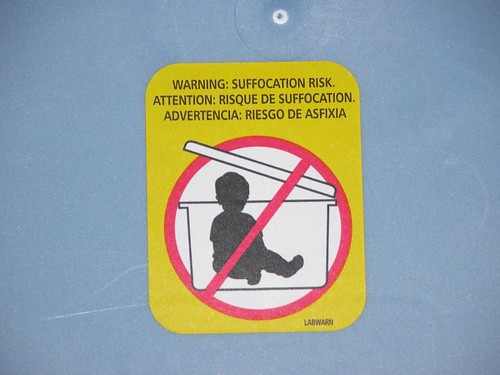Usability and design aren’t just concerns for web developers. They can make a real impact in the use and usefulness of physical products as well.
Warning labels are a great example – you can’t buy anything these days without some kind of warning label, and they are visual design elements intended to convey important information to buyers and users. I ran into two great examples in the course of packing up and clearing out our house.
Example number one is from a big plastic storage tub. It’s a great example of both usability and design, though the actual message might seem a bit silly. Do people really need to be warned not to seal their children inside airtight containers?
It’s great from a design standpoint because it is clean, puts clear emphasis on the important diagram, and uses bright, attention-grabbing colors. Any parents poised to place their toddler in the bin will not doubt see the label before recklessly replacing the lid. It’s a good usability case because it conveys information very clearly and effectively-the silhouette kid is immediately recognizable and it uses common conventions such as the red circle and slash to mean “NO!”
The second example is… well, strange and off-putting. We might laugh at the thought of tupperwared toddlers but fireworks obviously pose some danger. This series of warning messages from the back of a box of fireworks is, well… take a look for yourself. I recommend clicking on the image to zoom in in Flickr.
So what could have been improved from a design standpoint? For one thing, it would help if the coach and the two children in the second panel weren’t wearing what appears to be ghoulish, grimacing deathmasks. They look like a cross between some misguided ventriloquist’s dummy and the clown that haunts the nightmares of every five-year-old child. Cartoons caricatures can be very effective in warnings because we can remove unneeded visual detail to focus on what’s important and because people are accustomed to following short narratives in the style of comic strips. But not if they are so ugly.
What are the usability problems? Let’s start at the top. The phrase “Common sense coach reminds you to…” isn’t quite as clear and gripping as “Warning: suffocation risk” in the first example. The idea of using cartoons to illustrate each point is good, but the actual illustrations miss the point. Without the text, do you think you could figure out the meaning of each of these?
For more examples of how usability and information design impact the real world, see The Design of Everyday Things by Don Norman.

